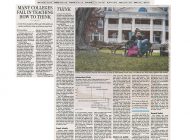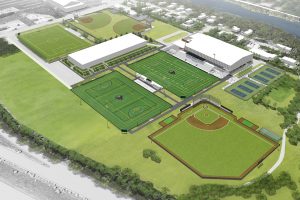PSU Meteorology Students Integrated Skills Across
Disciplines to Address Water Extremes in the West
PLYMOUTH, N.H.—Undergraduate and graduate meteorology students are acquiring and applying new skills that will improve forecasting for extreme precipitation caused by atmospheric rivers (ARs). This research project reflects PSU’s move from a traditional academic model to Integrated Clusters, giving students the combination of interdisciplinary learning, collaboration, and hands-on opportunities they need to compete in an increasingly complex and interdisciplinary world.
Atmospheric rivers are corridors in the atmosphere where water vapor is channeled from one location to another in large-scale weather systems. Depending on the climate, ARs can result in deadly flash flooding, landslides, and blizzards. Although atmospheric rivers develop in New Hampshire and all over the globe, California is a prime location for the research study, because ARs account for nearly half of the Golden State’s total rainfall, and cause about 80 percent of its major floods. In 2017, the state has already weathered a number of major storms triggered by ARs that produced record-setting Sierra Nevada mountain range snowpack, rainfall, and flooded coastal riverbanks and rural towns.
Effectively managing all that water during the dry months as well as the extremely wet ones has been challenging for the state, which employs hundreds of reservoirs to regulate water supply.
The PSU meteorology student-researchers, led by Assistant Professor of Meteorology Dr. Jason Cordeira ’05, an expert in forecasting precipitation extremes, and Assistant Professor of Environmental Science Dr. Amy Villamagna, who specializes in Geographic Information Systems (GIS), aim to develop tools to better forecast the timing, duration, and intensity of extreme precipitation events to inform California’s reservoir operations. GIS is a mapping system that helps users analyze data to understand relationships, patterns, and trends.
“The idea of forecast-informed reservoir operation is, if you can trust that it will not rain during the next two weeks you should not release water from the reservoir. If you’re expecting several inches of rain during the next two weeks, you could release water so the reservoir isn’t overwhelmed,” explains Cordeira.
The research is being conducted on the PSU campus in the state-of-the-art Judd Gregg Meteorology Institute in the Boyd Science Center.
According to Villamagna, GIS adds a new dimension to the research, allowing students to gather a broader range of information. “Our students are learning more than just how much rain is going to fall and where, but also what will happen once the water hits the ground,” she says. “With that data, they can measure the effects of ARs on watersheds, reservoirs, cities, towns, people, and policy. The students are learning a new and marketable skill—GIS—and applying it to a real phenomenon that has on-the-ground impacts.”
The PSU team’s research is funded by a four-year, $379,000 grant from the U.S. Army Corps of Engineers in collaboration with the Center for Western Weather and Water Extremes at the Scripps Institution of Oceanography in La Jolla, California, which is one of the oldest and largest centers for ocean and Earth science research. The partnership between Scripps and PSU was established in 2013 and has led to several research opportunities involving undergraduate and graduate students and jobs at Scripps for recent PSU graduates Brian Kawzenuk ’15G and Chad Hecht ’16G.
Cordeira believes it is the interdisciplinary nature of research at PSU that helped the University secure this latest grant and helped Kawzenuk and Hecht land jobs in their field immediately after graduating. “This grant comes at an opportune time when the University is moving toward a more interdisciplinary, integrative approach. This project includes elements of social science, computer science, atmospheric science, and environmental science and policy,” he says. “I think that was part of the appeal to Scripps when they decided to both fund this project and hire our graduates.”
Cordeira and Villamagna expanded their research team during summer 2017 in which one graduate student and three undergraduate students led interdisciplinary projects that aim to improve the understanding of forecasting extreme precipitation and its impacts over California.
Allison Young ’16G, a recent graduate of the M.S. Applied Meteorology program and one of the students on the research team, said her integrated and interdisciplinary research experience at PSU will give her an edge when she enters the workforce. “No Earth science exists on its own; they’re all connected,” she says. “All of the natural sciences are coming around to this idea that students and researchers need diverse skills to solve a problem. Thanks to this project, I feel like I’m already ahead.”
■ Barbara Alan
Tags:
applied meteorology
Barbra Alan
California
Geographic Information Systems
integrated clusters
Jason Cordeira ’05
Judd Gregg Meteorology Institute
meteorology
MS in Applied Meteorology
![]()


















